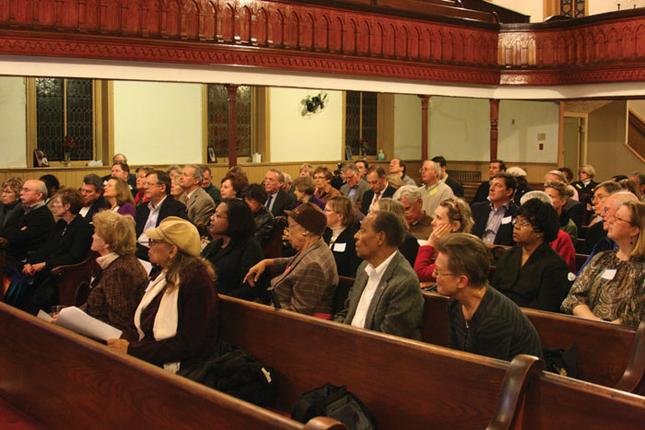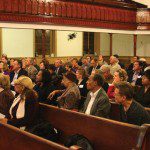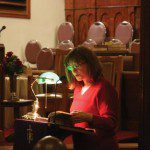Black History in Georgetown
By • June 18, 2013 0 2973

There’s so much ado about Georgetown, so much bustle, so many dollars and words and honks exchanged at a daily clip.
It’s nice to know there’s always time for a little history.
That was true at CAG’s monthly meeting on Feb. 22, held at Mt. Zion Methodist Church on 29th Street, a nod to Black History Month. Dozens of congregation members and other Georgetowners filed into the pews to hear the stories and words of an unlikely pair: Carter Bowman, the official historian for Mt. Zion, and Mary Kay Ricks, a one-time attorney who founded a walking tour company and, fascinated by the tales she uncovered, wrote a book on the rather hush-hush topic of slavery in Washington.
That book, “Escape on the Pearl,” is an exhaustively researched work on the tangled web of human bondage that clung to the capital’s upper classes: presidents, senators, powerful
socialites. It is also concerned with the little-known yet bold escape attempt of 77 slaves on a chartered schooner from Philadelphia named the Pearl. While historically the event is overshadowed by John Brown’s raid of Harper’s Ferry and the Kansas wars, it was viewed at the time as enough of an abolitionist shenanigan to spark riots across the city. The year was 1848 and secession was barely a decade off.
What ties the two speakers together is that Mt. Zion played an integral role in the daring flight of the Pearl. And, as Bowman explained, the church served as a refuge for those in shackles for much of the antebellum 19th century and a community locus thereafter.
Mt. Zion was founded in 1816 by black members of the Montgomery Street Church (now the Dumbarton Avenue United Methodist Church) who, though they usually comprised half of the congregation, were fed up with being segregated from white worshippers. Autonomy was not all theirs, however — members of the newly formed Mt. Zion still held services under the auspice of Montgomery and, as it turned out, were presided over by white pastors.
But it began a rich cultural and religious identity for blacks in Georgetown, who made up nearly a third of the population, the majority of them free men. It became one of the few places under law where blacks could congregate in large numbers, and it was, at the height of the abolition movement, a major stop on the Underground Railroad. Whispers would travel electrically through the congregation: who was being hidden in the churchyard, who was up for sale, which families were close to being rent apart. The success of the cotton gin in the early 19th century ignited a demand for slaves in the South, and so with it a widespread sundering of families as mothers and sons and sisters were sold downriver. Around 600,000 slaves were fated to endure this “Second Middle Passage” to New Orleans or other Southern cities. As Bowman explained, church “classes” really became organized sects for keeping abreast of the latest news on local slaves and, when possible, spiriting those away who were being bought up for market.
Mt. Zion, then, is immutably wrapped in the history of slave resistance in Washington. One of the Pearl escapees, Alfred Pope, was a member of the church and later bought a plot of land in Georgetown on which to build a permanent house of worship. After the war, after Emancipation, it burned to the ground in 1880, but was rebuilt four years later. Walking through it now, you can almost taste the history, the stories it has witnessed. You almost hear small noises, something like ghosts or singing voices long past. CAG President Jennifer Altemus called it the “perfect venue” to discuss Ricks’ story.
“[This church] puts you in a place, gives you a feel for the history,” Bowman said. At 87, he has seen a good portion of it.
Ricks is much younger, a scholar at heart, with a soft and wavering voice that teems with emotion. Her book centers around Mary and Emily Edmonson, daughters of a free black man from Georgetown. Because their mother was a slave, however, they inherited their bonded status,
along with 12 other siblings.
The year was 1848. At that time, slavery was hardly taboo in Washington. Having been comprised of land ceded by slave states, the city was firmly rooted below the Mason-Dixon line, and slavery, as Ricks put it, “literally came with the territory.” Dolley Madison owned a slave late into her life, which she sold to Senator Daniel Webster the year before the Pearl made its dash for the North. That slave, Paul Jennings, was one of three men who conspired to charter a ship that would whisk away the slaves of Washington. The other was Samuel Edmonson, the older brother of Mary and Emily. The plan was simple: gather up the slaves marked for sale, steal away in the night to the ship and sail up the Chesapeake to safety. For a few, it was the only option.
“Many of the people boarded the Pearl that night because their security … was threatened by the slave trade,” Ricks said.
She went on to tell how, on a foggy August evening, the Edmonsons and the rest boarded the Pearl, moored close to the future site of the Washington Monument, and sailed away. They made for Point Lookout, the mouth of the Potomac, but when they arrived they found the weather had made it impassable. The captain, a white Pennsylvanian, had no choice but to anchor the boat in a leeward cove. Slaveowners in Washington had already awakened, discovered the plot and were in hot pursuit. Anti-abolitionist riots had already begun surging across the city.
The Pearl was eventually discovered right where it was anchored, its passengers manacled and dragged back to Washington. Most were sold and sent to New Orleans as punishment. One of the luckier Pearl escapees was Alfred Pope, whose owner took him back and freed him in his will two years later. He was serving on Mt. Zion’s board of trustees when he appointed
the 29th Street space nearly 30 years later, a free man.
Mary and Emily Edmonson became one of the first causes for a young Henry Ward Beecher,
the flamboyant abolitionist preacher who later would ship rifles (“Beecher’s Bibles”) off to Bleeding Kansas. With his sister, Harriet Beecher Stowe, they secured the Edmonson sisters’ freedom and their admission to Oberlin College.
It was a story the audience had trouble digesting. A silence, an eeriness hung in the air a moment, the realization that those on the front line of this country’s greatest conflict, the figures in old daguerreotypes, the names in textbooks, had once been a part of or helped this congregation, now housed in the very church where they sat. It was black history, American history, animated and made real.
Also in Georgetown:
As always, store openings and closings are making a few headlines this week. No word yet on the rumors surrounding a new Nathans tenant. Late-night junk foodies will be disappointed
to learn Philly Pizza has been ordered to shut down by the city’s Department of Consumer
and Regulatory Affairs. The Potomac Street pizza parlor, which is open until 4 a.m. on weekends, was found to have exceeded its allotment of carry-out orders, a violation of their license to operate as a sit-down restaurant. This would routinely attract a throng of noisy bar-hoppers and students, who clashed with neighbors across the street. This may not concern you if you’re somewhat of a pizza connoisseur, but the opening of Il Canale (1063 31st St.) should. We stopped by for a slice and were impressed. If you need a break from Pizzeria Paradiso, check out this new addition to the Georgetown restaurant scene. Finally, Georgetown’s Benetton store recently closed for remodeling. It should be ready by April, just in time to pick up some pastels and cashmere for spring.
Last month’s Jelleff imbroglio at the ANC meeting should be enough to convince you community politics are heating up this year. Ready for more? Stop by the next ANC meeting
on March 1 at Georgetown Visitation, 35th Street and Volta Place, 6:30 p.m.
- The audience at Mt. Zion Methodist Church | Garrett Faulkner



